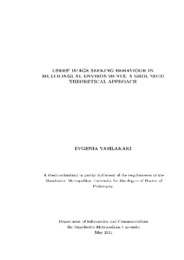Users image seeking behaviour in multingual environments: a grounded theoretical approach
Abstract
This Thesis aims to explore users' image seeking behaviour in online multilingual
environments. In particular, it focuses on identifying users' actions/interactions- and
on enquiring into users' rationales and justifications for their actions. In addition, it
aims to identify the factors which have affected and/or informed users’ image seeking
behaviour in multilingual environments. In this context, an inductive research approach
and specifically ‘Grounded Theory’ as a methodology were adopted. A mixture of
four different methods (questionnaire, observation, retrospective thinking aloud and
interview), both qualitative and quantitative, were employed for data collection.
For the purposes of this thesis, two studies were conducted. In particular, an
Exploratory Study served as the means for gaining a first insight into users’ image
seeking behaviour. This in turn, informed the design and conduction of the Main Study.
A procedural analysis of the data collected was adopted focusing on identifying users’
actions/interactions, their rationales behind these actions and finally the consequences
of these actions.
A substantive theory of users’ non-linear image seeking behaviour in a multilingual
context emerged from the data. In particular, twenty seven concepts and numerous
codes emerged and were accordingly assigned to the three distinct areas: conditions,
actions and consequences. In the quest for a higher conceptual analysis, four conceptual
categories were identified in the concepts: Knowledge of Languages, Query Domain,
System and Search. Diagrams were used to illustrate the theory found in data, to
demonstrate the relationships among concepts and to gain analytical distance from
data.
This thesis contributes to our understanding of the diversity and complexity of
users’ searching experiences in multilingual environments and fills a gap in the relevant
literature by providing substantive insights into the relationship between the interface
and users’ actions. In addition, it contributes to learning how users’ perceive, adopt
and adjust MLIR systems to their needs and their search behaviour. This in turn,
contributes to informing the design of efficient MLIR systems which support effective
search behaviour and performance.
